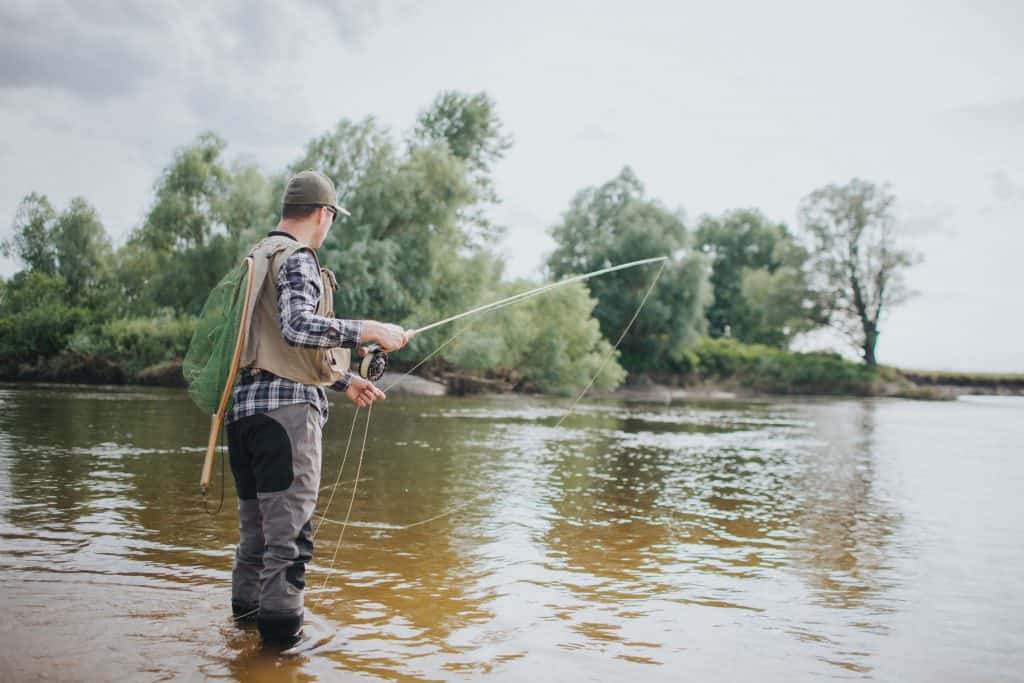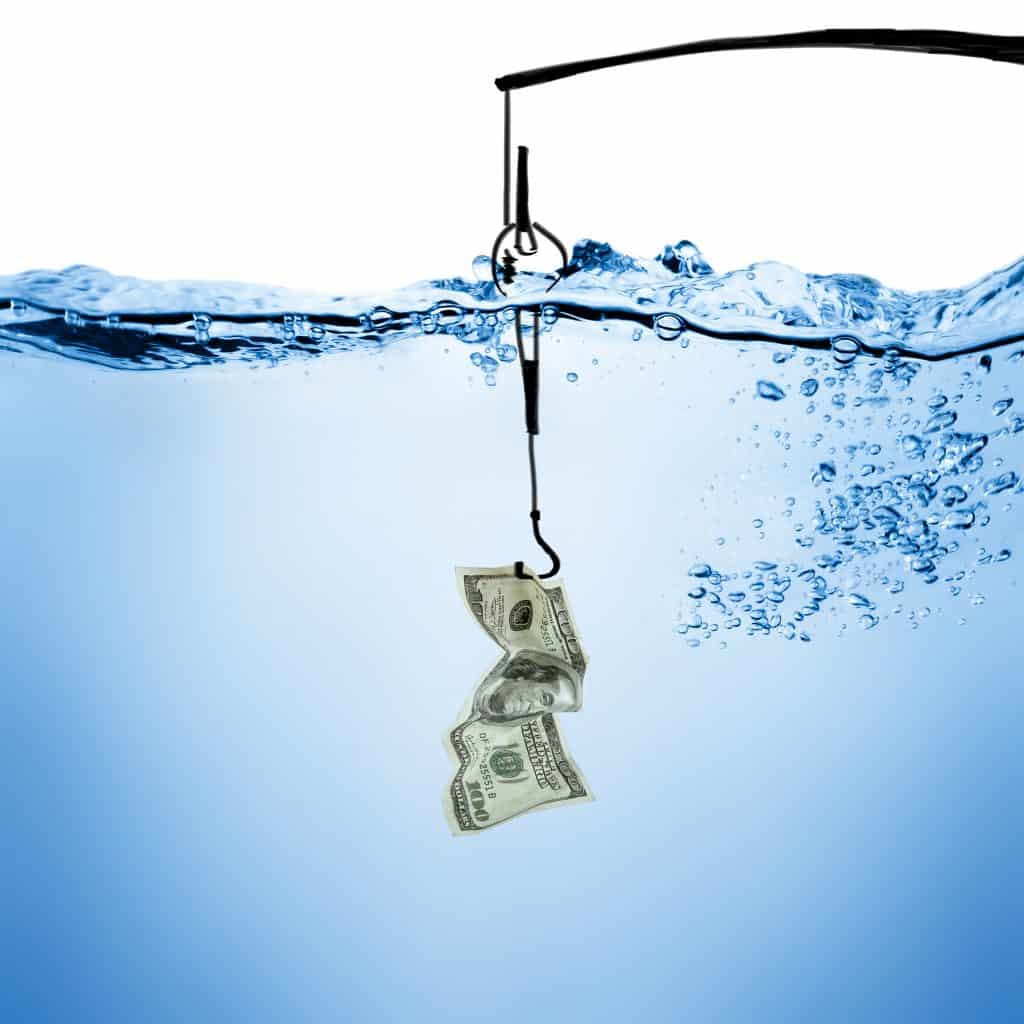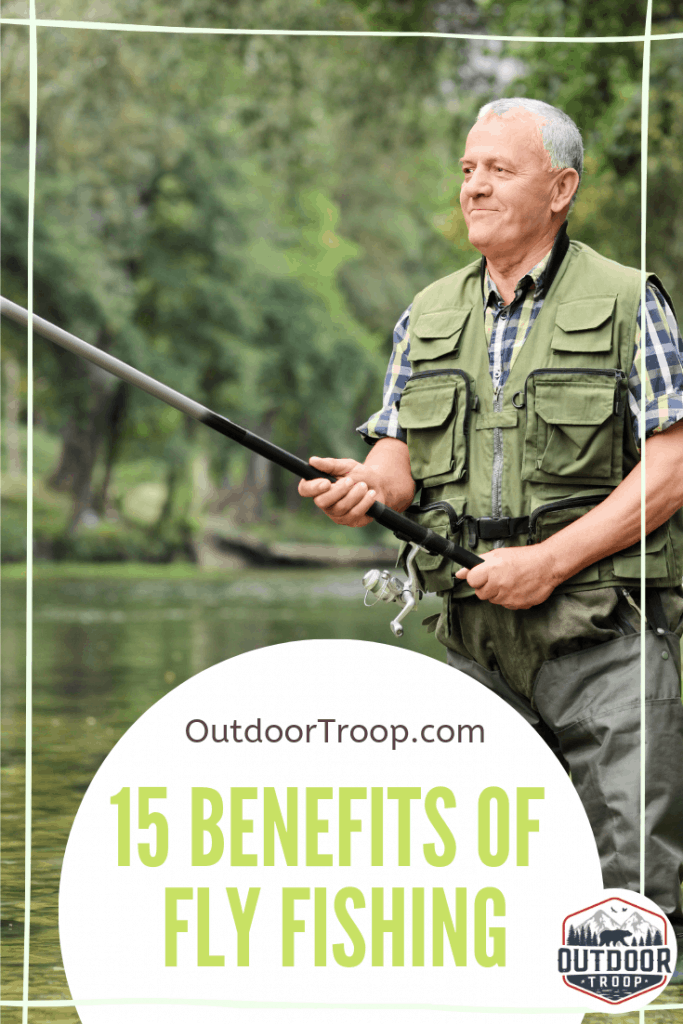
There are countless hobbies and activities that you can choose to get involved in. Sometimes it’s hard to know what activity will be best for you and which one you’ll get the most out of. I’d like to recommend fly fishing because there are so many ways that it can be useful and enjoyable!
Here are 15 benefits that fly fishing can bring to you:
- Physical Fitness
- Collect Quality Flies
- Time in Nature
- Low Environmental Impact
- Wider Access Fishing
- New Techniques
- Wildlife Education
- Specialize Lures
- Tie Flies
- Relatively Inexpensive
- Durable Equipment
- Fishing for Food
- Social Bonding
- Goal Achievement
- Support Conservation
This is just the tip of the iceberg when it comes to why fishing is worth your time. We’ll break down each of these benefits and their elements below.
Physical Fitness
Fly fishing is a good hobby to get into if you want an enjoyable and easy way to stay active. Fly fishing exercises various muscle groups in different ways than the average gym workout does. The motions of climbing, wading, and casting let you exercise your body in a different way than it’s used to.
Fly fishing can also help with the development and improvement of fine motor skills. This occurs when you practice small, precise movements such as untangling a line, attaching hooks, and reeling in fish. Fishing frequently can help keep your hands flexible and dexterous in a way that most formal workouts won’t!
The physical activity required in fly fishing is also more subtle than other forms of exercise. Most of the movement you’ll be doing is continuous and requires a constant low energy output. Actions like casting a line and leaning against a current provide a slow and steady workout.
In an average session at the gym, most people will burn about 200-300 calories. But after a day of fly fishing, it’s not uncommon to have burned 500- 1,500 calories without hardly realizing it! You may be tired at the end of a long trip, but it doesn’t require as much effort and commitment as a session at the gym.
Collect Quality Flies
One of the main differences between fly fishing and bait fishing is that fly fishing requires lures that are made of synthetic, inedible materials. Each fly is meant to imitate the appearance of a specific insect, grub, or small fish.
The main benefit of using flies instead of edible bait is that you won’t need to buy new lures every time you go fishing.
You’ll be able to reuse flies that have worked in the past, and using them will eventually become cheaper than buying fresh bait every trip. In addition, most flies are made from material that won’t break down in water, even if they’re frequently submerged.
This means that the initial cost of buying fly lures will quickly negate itself because they are meant to last for a long period of time. As you experiment with different lures, you’ll be able to gain a collection of flies that you know will be effective.
Time in Nature
Fly fishing is also good for your mental and emotional health. Sometimes life can get overwhelming and it becomes easy to get distracted by our phones, work, and other commitments.
Fishing is a chance for you to escape the stress and everyday concerns. In nature, there’s not nearly as much stimulus to distract you from what you’re doing. It can be very soothing to take some time for yourself in nature and just focus on one thing.
If you choose to go alone, you can take some time away from other people as well. No matter how social you are, it’s important to create some alone time to let your thoughts settle.
The slow, continuous motions involved, such as casting and reeling in the line can also be therapeutic with their rhythm. There’s not much background noise apart from the flow of water, so you can also get the benefit of soothing white noise.
Low Environmental Impact
Although no form of fishing is going to be necessarily good for the fish, fly fishing is one of the least harmful ways to go about it. Since you’re not using edible bait, you avoid the risk of introducing foreign species or processed food into a natural environment.
You can also help keep the environment healthy by keeping the populations of fish in check. If you follow the catch and size limits for each area you visit, the activity of fly fishing can be a good thing for the local wildlife. Responsible fishing can even limit invasive species and prevent rapid population growth.
Wider Access Fishing
As a fly fisherman, you’ll also have access to more fishing territory than those who use edible bait. There are certain areas that prohibit the use of live bait because of the compounding effects it can have on the fish populations and their natural environment.
In areas such as this, fly fishermen won’t be affected! Since fly fishing is one of the lowest impact methods, it’s practice is allowed in almost every location that fishing is permitted.
In addition, fly fishing can sometimes provide greater reach and precision than other techniques. Depending on the length of the rod you’re using and the weight of the line and fly, you can target certain areas of water with great accuracy.
New Techniques

Learning how to fly fish requires a good deal of time, practice, and dedication. But if you put in the effort, this will enable you to learn a new skill that you didn’t know before! Picking up new hobbies and activities have been shown to provide wonderful psychological benefits as you practice and improve.
As you work on developing the techniques that are necessary for fly fishing, you’ll be able to make connections between existing skill areas in your brain, increase your learning speed, and even get better at fighting off boredom!
Coupled with the mental and physical benefits you get from the exercise and tranquil time in nature, learning how to fly fish can be extremely beneficial for your state of mind.
Wildlife Education
Fly fishing will require you to do some research on your local area and environment. Before you begin fishing, you’ll want to know what kind of fish you want to target and what their preferred prey is.
Much of this information is something you could learn through observation of the fish and insects that you have seen in the past, but there are other ways to learn as well.
Flipping over river rocks and collecting samples of aquatic insects is one way to catalog the local species. Keeping track of the hatching and migrating seasons for certain kinds of insects can also help you choose the right flies for each time of year.
In addition, you can ask local bait shops and other fishermen what they have tried and found to be effective in the past. These methods will help you create a trustworthy collection of flies that you’ll know when and where to use.
You’ll also become more knowledgeable about your area and local wildlife that it supports. This will come in handy as you apply it in the future and use it to give advice to others.
Specialized Lures
As you get more practiced with fly fishing, you’ll begin the recognize the benefits of different types of flies. Artificial lures are separated into two different types: wet flies and dry flies.
Wet flies are patterned after aquatic insects, small fish, and underwater grubs. They’re generally larger and heavier than dry flies and can be used to attract the attention of fish who live in deeper waters.
Dry flies
As you can more practice with each type of lure, you’ll be able to appreciate the differences between the two. Fly fishing enables you to apply your knowledge of fish’s feeding habits. It gives you an opportunity to practice your skill at choosing and casting different types of bait and knowing which ones will be most effective for the fish you’re targeting.
Tie Flies
This isn’t necessary for everyone who’s interested in fly fishing, but many fishermen enjoy tying their own unique lures. Tying flies creates a chance to learn an applicable new hobby, and possibly even turn it into a marketable skill!
Tying flies isn’t for everyone and it requires a significant amount of time, materials, and skill to get it right. But as with everything, practice makes perfect. The more you do it and the more flies you make, the better you’ll get at it. It might not be cost efficient at the beginning, but once you’ve tied a couple hundred flies, you’ll begin to save money on buying store bought packs.
In addition, many experienced fly fishers have been able to sell their custom designs to other interested fishers or retailers.
But beyond any monetary gain, this is a chance to learn another new skill that you can apply in your life. You can become self-sufficient at crafting bait.
The practice of tying your own flies creates an opportunity for you to make a concrete product that you can perfect and use in your hobby. As is the case with learning how to fly fish, this provides psychological and emotional benefits.
Relatively Inexpensive

Fly fishing is also a fairly cheap hobby to get invested in. There will be some initial costs at the beginning because you’ll need to purchase a fly rod, a pack of starter flies, a license, and some additional gear such as waders and a repair kit.
But once you get past the first price bump, fly fishing is a very cheap hobby to maintain. You won’t need to buy bait every time you go out, and your equipment upkeep is simple.
There are a few recurring expenses when it comes to fly fishing such as renewing your license annually and switching out flies from time to time. But from one trip to the next, the expenses will be virtually nonexistant!
Durable Equipment
Relating to the last point, fishing gear is usually built to last. Although you might need to spend a couple hundred dollars to buy a set of good quality equipment, it will be usable for years, and potentially even a lifetime!
Fishing lines may break and tangle, but the rod itself is built to bend and not break under pressure. It’s very rare that you’ll need to purchase a new rod because they are built to be durable and difficult to break. And if you invest in a good pair of waders, those can last for a long time without leaking.
Though you’ll need to replace flies from time to time, these are built to last for a while as well. The materials that are used to make most flies takes a long time to break down naturally. They are also usually designed with rigid forms that won’t ruffle or break apart.
Fishing for Food
Although catch and release fishing can be fun and relaxing, sometimes it’s fun to reel in a big fish and take it home to eat! There’s something very satisfying about cooking and eating a fish that you caught fresh from the river. You can’t get a much fresher source of food than one that you’ve pulled straight out of nature.
There are a variety of recipes that you can use fresh fish in, so it’s easy to find one that’s suited to your particular level of cooking. If you catch enough fish, there’s also an opportunity for you to cook enough food to share with others (which lets you show off both your fishing and your cooking skills!).
Social Bonding
Fly fishing is an activity that you can do alone or with other people. Many people enjoy the tranquility of fishing alone, but it can also be a great way to spend time with others and grow closer with them.
Fishing with friends and family lets you bond with them in a setting that’s different from your usual social situations. When everyone is out in nature, it’s easier to relax and let down their usual walls. The setting feels less formal and more relaxed.
It’s not always even necessary to talk to each other during these experiences! Sometimes just quietly spending time together can help people grow closer as well. If you go fishing with the same people multiple times, you can all create this positive connection with each other.
If you spend time with people in a comfortable and calming environment, they’ll begin to associate those feelings with your presence. This is one of the reasons why groups of people who go fishing together will often do so frequently and maintain close friendships.
In the event that you catch “the biggest fish anyone’s ever seen” you’ll also have fishing buddies who can back you up! Some experiences are better when they’re shared with others.
Goal Achievement
One of the reasons that fly fishing is so enjoyable is because it enables you to set a goal and achieve it. When you decide you want to go fishing, you can follow a reliable process and often leave with a concrete reward. In this case, the reward is fish!
Whether or not you choose to release the fish or take it home, the act of targeting and catching a fish is very satisfying for most people. In a world of digital records and nebulous goals, it can be refreshing to set out with a singular purpose and pursue it.
In addition, if you can physically hold the reward that you earned, it gives you a certain sense of achievement.
Support Conservation
When you fish at a stocked river, purchase an annual fishing license, or pay to fish at a state park, you’re demonstrating to the state and national government that the environment is important to you. Because you take part in this hobby, you automatically become a patron of wildlife protectors.
In addition to the funds that you provide to the fish and game department, it’s easy for lawmakers to see that protecting and preserving natural resources is important to you and other fishermen. This will help them take the environment into greater account as they consider directing energy and funds toward conservation projects.
When you become invested in fly fishing, you also become invested in the future of the natural world. With luck, future generations will be able to enjoy the same benefits that you have.
Related Questions
Is fishing relaxing? Fishing is a relaxing activity for most people due to the light physical activity that releases endorphins. There is also a psychological benefit that can be gained by spending time in nature and removing yourself from environments of stress and pressure.
What is the difference between regular fishing and fly fishing? Fly fishing is a technique that requires a lightweight artificial lure that imitates a real bug. Bait fishing requires a piece of edible bait such as a live insect or another kind of attractive food. Each technique also requires a different type of fishing rod.

